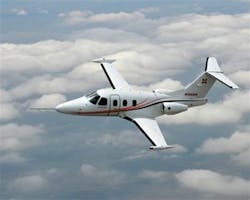America's already crowded skies are about to become more congested. Taking off for the first time this year will be small, speedy, cheap jets that big airlines worry will cause traffic jams around major metropolitan areas.
Called "microjets" or "very light jets," they've been likened to SUVs with wings. With two engines and seating capacity for five or six people, they cost half as much as the most inexpensive business jet now in service.
Three thousand of the little jets are already on order at three manufacturers. Albuquerque, N.M.-based Eclipse Aviation has 2,350 on back order and expects to receive Federal Aviation Administration certification for its E500 by June. The first E500 - which takes less than five days to make - will be delivered 10 days later.
The FAA and airline pilots are wary of the sudden emergence of a new class of jets. But Vern Raburn, the brash founder of Eclipse Aviation, scoffs at the notion that VLJs will blacken the skies.
The airlines and manufacturers that have been around for decades have the attitude, Raburn said, that "if it hasn't been done before, it can't be done or it won't be done or it shouldn't be done."
"The question is exactly where they're going to be flying," said FAA chief Marion Blakey. "How much is in congested airspace? It's probably not knowable at this point."
Supporters of the little jets predict they'll go to out-of-the way sites, in the vast empty skies between more than 5,000 small, underused airports.
"We're going to offer service where the airlines don't," Raburn said.
Duane Woerth, president of the Air Line Pilots Association, the largest pilot union, said it's more likely the new jets will swarm to the busy airspace above the 35 biggest airports, through which 95 percent of all air passengers travel.
"A lot of these guys aren't going to want to go to a farm patch in Scribner, Nebraska," he said.
The FAA predicts at least 4,500 VLJs will be in service 10 years from now, though Blakey concedes that's a conservative estimate. NASA projects 20,000 in 2010.
To the radar scope and to the controller, there's no difference between a little jet and a jumbo jet.
If only 2 percent of commercial air passengers move from jetliners to very light jets, Blakey said, that will triple the number of takeoffs and landings that air traffic controllers have to handle.
"You say, `Whew, we're going to have to be prepared for this phenomenon,'" Blakey said.
The FAA is moving away from navigation by controllers on the ground to navigation by pilots in the cockpit, using the satellite-based Global Positioning System and powerful computers.
Satellite-based navigation will permit more airplanes to fly closer together, Blakey said. He believes that VLJs will prod the government to push more quickly toward a satellite-based navigation system.
Blakey is concerned that VLJs will clog the single-lane highways in the sky above 18,000 feet, where large jets fly. Unlike turboprops, which cruise below 30,000 feet, VLJs cruise at the same altitude as jetliners - between 30,000 and 40,000 feet. But they cruise at 430 miles per hour, considerably slower than a 737, which flies at 500 mph.
Jim May, president of the Air Transport Association, said they'd be like cars going 45 mph on the freeway.
Raburn, who's been a pilot for 40 years, said that's not a worry. "The sky ain't crowded above 18,000 feet," he said.
He envisions a national network of air taxis, for-hire limousines with wings that will be able to land at thousands of runways where jetliners and executive jets can't. VLJs can land on runways as short as 3,000 feet, compared with the 4,000 or 5,000 feet required by the smallest jets now being flown.
VLJs will come equipped with high-tech safety and navigation equipment, which will allow them to fly into small airports in less-than-ideal conditions. Adam Aircraft's A700, for example, sells for $2 million and has more sophisticated avionics in the cockpit than a $40 million Gulfstream G5, said company president Joe Walker.
Others dismiss VLJs as so much pie in the sky.
NASA, which has been promoting VLJ technology, asked the National Research Council to report in 2002 on the feasibility of the concept. A committee of retired aviation industry executives and academics gave it the thumbs-down.
"The committee does not share NASA's vision," the report said, noting that aircraft could never be affordable for large numbers of people and businesses. It further concluded that they wouldn't attract passengers if they didn't serve big cities, and they couldn't use small airports that don't have navigation aids, control towers and radar. Noise would keep them away from small airports that did have such equipment, the report said.
Walker predicted the jets will appeal to wealthy businessmen eager to avoid the unpleasant and time-consuming experience of getting to an airplane at a busy airport. "It's uber-first class," he said.
Raburn differed from that characterization. "It's uber-convenience," he said.
___
On the Net:
Federal Aviation Administration: http://www.tsa.gov
Eclipse Aviation: http://www.eclipseaviation.com/
Adam Aircraft: http://www.adamaircraft.com/
News stories provided by third parties are not edited by "Site Publication" staff. For suggestions and comments, please click the Contact link at the bottom of this page.






